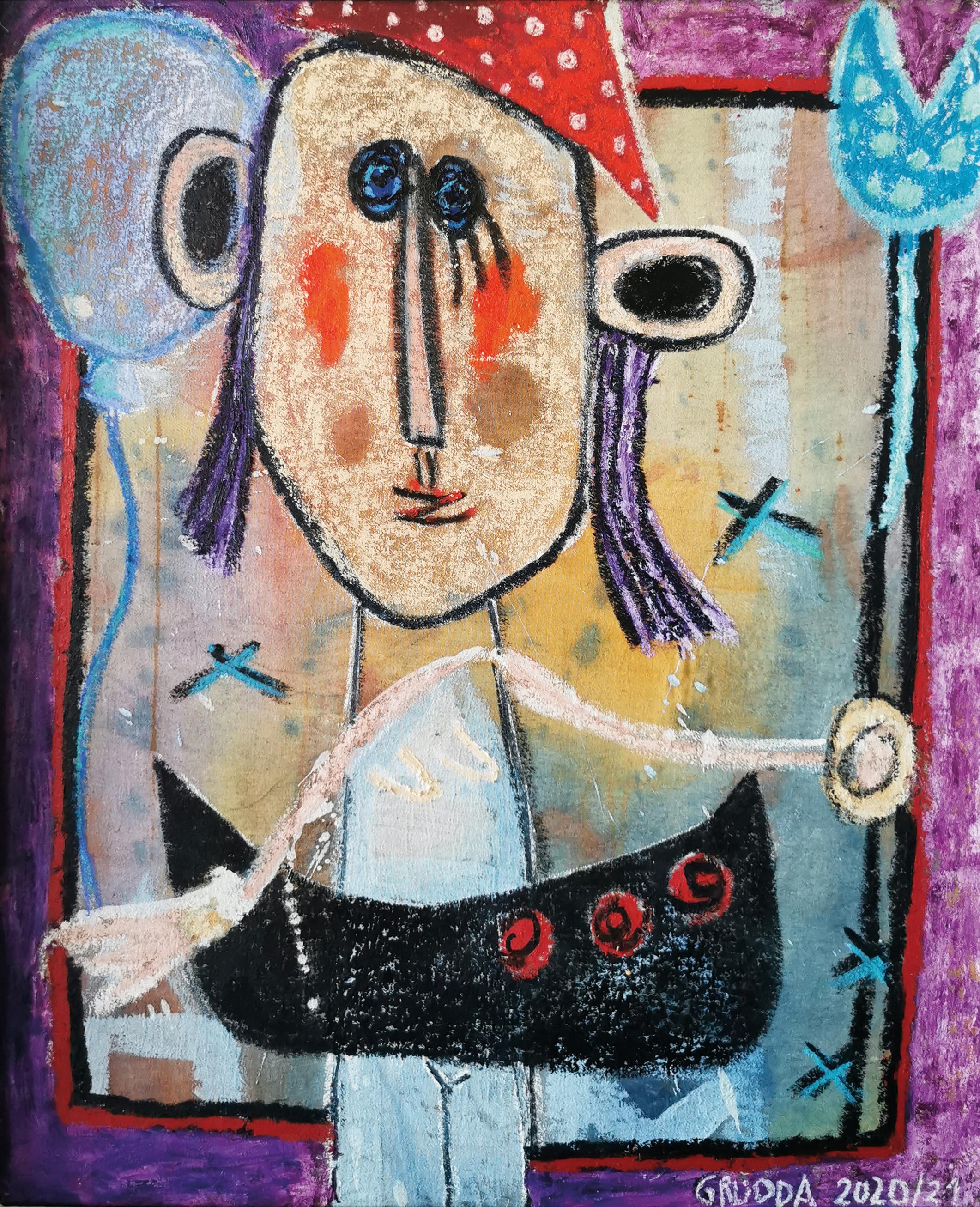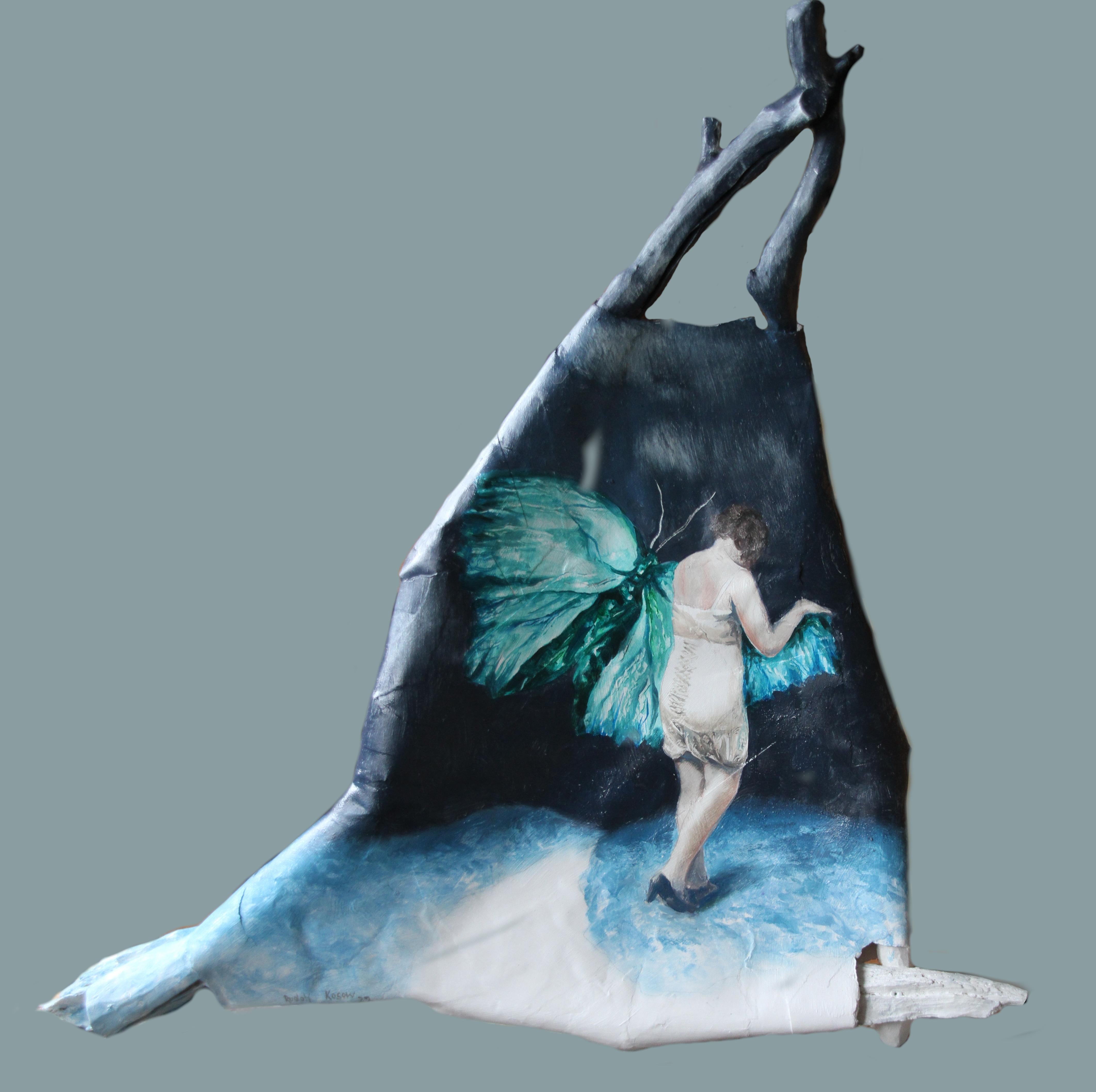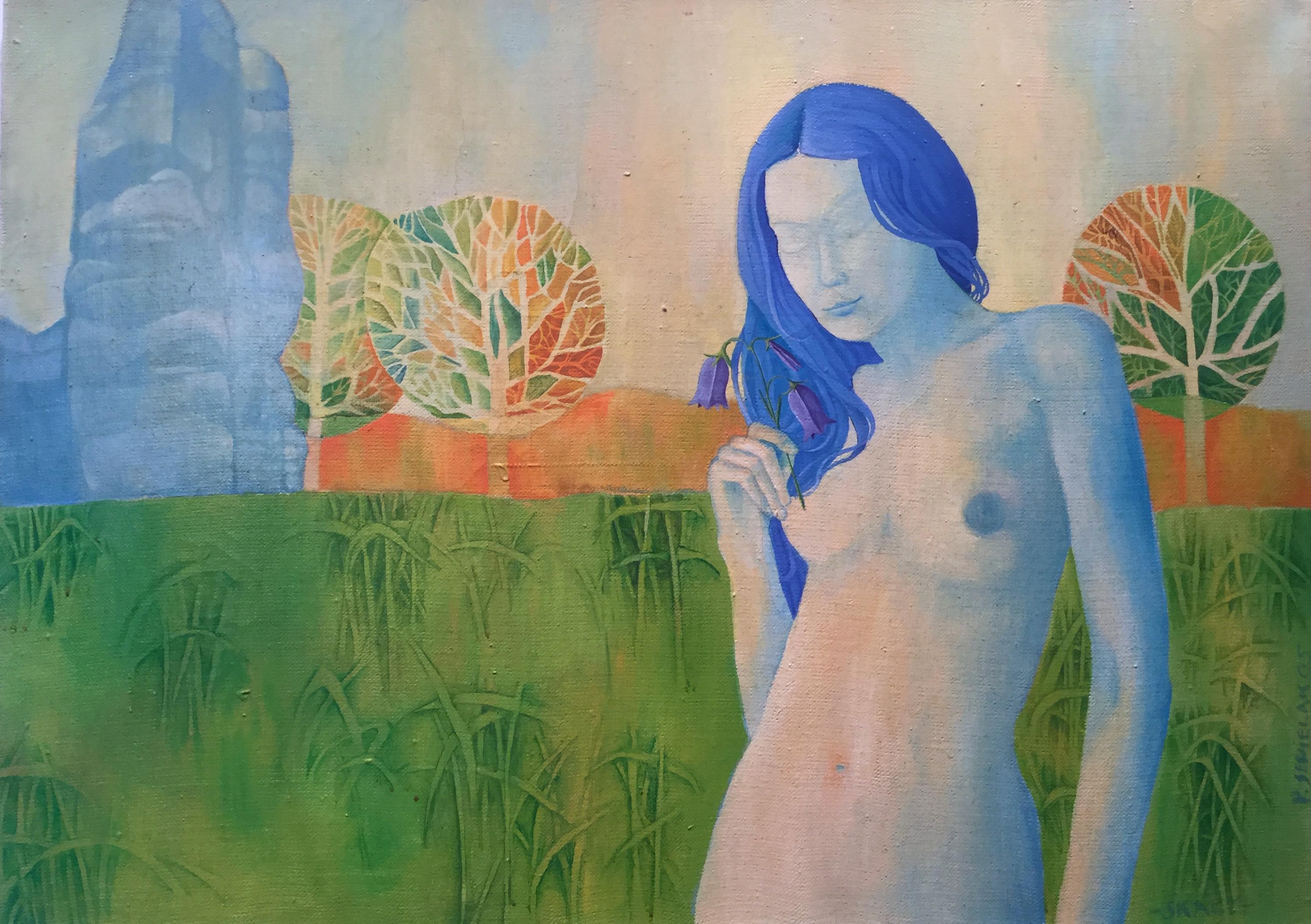Items Similar to Penitent Magdalene and St. John the Baptist, oil on slate, early 17th century
Want more images or videos?
Request additional images or videos from the seller
1 of 21
UnknownPenitent Magdalene and St. John the Baptist, oil on slate, early 17th century 1600s
1600s
About the Item
The figure of the Magdalene emerges from the
darkness, leaning to follow the curve of the stone
support; it is depicted vaulted with an interrogative
air towards the dark, as if in an attitude of listening,
the left hand raised and the other leaning on the
"memento mori" very shortened. In front of her a
scourge and the jar of ointment.
Painted en pendant, Saint John the Baptist is depicted
as a young man, with a lamb at his feet, in his hand
the processional cross with the banner "exception
agnus dei", while with his right hand he draws from
the source of water, recalling the episode that will see
Jesus Christ baptized.
In both paintings the figures stand out in a strong and
incisive way thanks to the black that characterizes the
slate plate on which they are depicted.
Historical-critical analysis:
We are faced with two examples of oil painting on
stone. The beginnings of this particular technique are
to be placed in the first half of the sixteenth century:
after some fifteenth-century experiments it is with
Sebastiano del Piombo that the genre takes hold in
the sixteenth century. There were different types of
support used, also linked to their availability:
amethyst, marble in various colors, alabaster and
blackboard. The reasons underlying this technical
choice refer to Renaissance artistic theories: it is no
coincidence that the painter who most often
experimented with oil painting on marble was Vasari,
the artist / intellectual who decisively influenced
theoretical thinking on art in the sixteenth century.
The great Renaissance collections of ancient art could
not fail to enter with their demonstrative force in the
debate on the "comparison of the arts": what better
proof of the superiority of sculpture over the painting
of the eternity of stone in the face of the almost total
loss of the pictorial evidence of classicism? So then
the choice of a non-perishable support such as canvas
or wood could be read as a "passage of degree" of
painting in the field of incorruptible stone.
At around 1500s and 1600s, the genre enjoyed
particular success in the Venetian Republic in its form
of oil painting on blackboard or touchstone. Surely
the proximity of the Brescia mines and the Brembana
Valley favored the development of this type of
paintings, as evidenced today by the studies of Linda
Borean who records the presence of a considerable
number of paintings in the Venetian collections of the
early seventeenth century, with a production mostly
linked to a shop commissioner, to respond to the
needs of the private devotion of the emerging
mercantile bourgeois class.
But the choice of such a dark stone as a background is
not only linked to practical reasons: as our two works
show, the emergence of the figures from the dark
background to the light also fully responds to the new
needs of the painting of the time. In the troubled
climate of the Counter Reformation, a new research
will develop that will lead to the need to express not
only the idealized existential certainties of the full
Renaissance, but also the anxieties and the opening to
new phases, which will already lead Tintoretto to
greater attention to reality. and to the luministic
contrasts, to then lead in an overwhelming way into
the seventeenth-century research strongly played on
the contrasting combination of light and shadow.
A more particular analysis of our two works can be
made referring to the studies dedicated to the
Veronese ateliers, in which the use of the blackboard
as a support for oil painting was particularly popular.
Among the best known authors was Felice Riccio,
known as Brusasorzi (1539-1605), and his pupils,
such as Alessandro Turchi, called Orbetto (1578-
1649), or Pasquale Ottino, called Pasqualotto (1578-
1630). The Magdalene painted here is similar in
appearance to a painting from Orbetto preserved in
Brera (it is a painting on canvas, datable to the fourth
decade of the 1600s) and reproduces the moderate
Caravaggesque realism combined with a classical
Emilian sweetness. Venetian, clearly visible in the
face, real but at the same time sensual and sweet.
On the other hand, the pictorial modes are closer to
those of Ottino, of whom we know, from recent
studies, a considerable body of works on stone, which
largely contributed to the spread of this production,
especially in the Veronese workshops. In fact, in
addition to the long-known works, including a Psyche
in the Giusti collection and the Resurrection of
Lazarus in the Borghese Gallery, the corpus has
significantly expanded to include a large production
of small-sized works, intended for private clients. The
two works described here, a clear production of the
Venetian area from the early decades of the 1600s,
can be attributed to this area.
- Creation Year:1600s
- Dimensions:Height: 17.33 in (44 cm)Width: 13.19 in (33.5 cm)Depth: 1.58 in (4 cm)
- Medium:
- Period:Early 17th Century
- Condition:
- Gallery Location:Milan, IT
- Reference Number:1stDibs: LU68039752872
About the Seller
4.8
Gold Seller
These expertly vetted sellers are highly rated and consistently exceed customer expectations.
Established in 2017
1stDibs seller since 2017
103 sales on 1stDibs
Typical response time: 1 hour
- ShippingRetrieving quote...Ships From: Milan, Italy
- Return PolicyA return for this item may be initiated within 14 days of delivery.
More From This SellerView All
- Painting with Scene of Battle 18th centuryLocated in Milan, ITOil on Canvas. Northern Italian school of the 17th-18th century. The scene features a clash of knights outside the walls of a besieged city, with smoke from firearms invading the sky...Category
18th Century Other Art Style Figurative Paintings
MaterialsOil
- Panel painting Annunciation 16th centuryLocated in Milan, ITOil on Board. Central-Italian school of the second half of the 1500s. The sacred scene of the Annunciation sees the two protagonist figures placed in the foreground in an interior th...Category
16th Century Other Art Style Figurative Paintings
MaterialsOil
- Deposition of Christ from the Cross, 1600s, 1700sLocated in Milan, ITOil painting on canvas. Northern Italian school of the 17th-18th century. On the back this label of the Art Gallery with the indication "Venetian School of 1600". The Gospel episode of the deposition of...Category
Late 17th Century Other Art Style Figurative Paintings
MaterialsOil
- Erminia among the Shepherds, Louis Dorigny attributable toLocated in Milan, ITOil painting on canvas. The large canvas recounts an episode taken from the Gerusalemme Liberata by Torquato Tasso, in which the young Erminia, princess of Antioch secretly in love w...Category
Late 17th Century Other Art Style Figurative Paintings
MaterialsOil
- Rest on the Flight into Egypt Oil on Canvas XVIII-XIX CenturyLocated in Milan, ITOil painting on canvas. XVIII -XIX century. The sacred theme in this scene takes on a familiar connotation, full of very earthly tenderness and intimacy: in an almost exotic context, which evokes an oasis in the desert...Category
Late 18th Century Other Art Style Figurative Paintings
MaterialsOil
- Madonna with Child Angels and Saints, XVII-XVIIIth centuryLocated in Milan, ITOil painting on canvas. Northern Italian school of the 17th-18th century. The work of a devotional nature, sees the Madonna, seated on the clouds and assisted by two angels who suppo...Category
Late 17th Century Other Art Style Figurative Paintings
MaterialsOil
You May Also Like
- The Red Dancer - Mid-Late 20th Century Figurative Elegant Ballet by Frank HillBy Frank HillLocated in Watford, HertfordshireFrank Hill is a professional artist living and working in North Norfolk. He studied art at Waltham Forest School of Art and later at St Martins School of Art. Frank’s professional c...Category
1970s Post-Impressionist Figurative Paintings
MaterialsOil, Board
- Imbarcato, fuga in barca volanteLocated in Milano, MILooking at her works of art, at first sight one is amazed, because still unfamiliar, in front of her fantastic creativity. Her characters seem to come from "different" worlds, sometimes distant, other times hidden within us. They walk through the woods and meadows, they peer over the shores where the waves break in a continuous and unstoppable dialogue. Often very small, hiding among the blades of grass, but also huge figures, like the characters from the fairy tales of when we were children, naive and still "pure". Here, this purity of childhood is slowly and inexorably awakened in us by looking at the works of Carin Grudda...Category
2010s Contemporary Figurative Paintings
MaterialsCanvas, Oil Pastel, Oil, Board
- Hermits (blue butterfly Woman vintage lingerie surrealist oil painting sculptureBy Rudolf KosowLocated in Quebec, QuebecHermits is a tridimensional original painting on paper on branches depicting a woman next to a giant butterfly along a path in a dark night. keywords; butterfly, woman, lingerie, americana...Category
2010s Surrealist Mixed Media
MaterialsOil, Driftwood, Laid Paper
- Untitled - Girl With Blue Hair - Surrealistic Oil Painting - NudeBy Pawel SepielakLocated in Salzburg, ATPawel Sepielak is a Polish painter, book illustrator and printmaker.Category
Early 2000s Surrealist Figurative Paintings
MaterialsCanvas, Oil
- “Bruyères en fleurs” 1949, 20th Century oil on canvas by William Didier-PougetBy William Didier-PougetLocated in Madrid, ESWILLIAM DIDIER - POUGET French, 1864 - 1959 BRUYÈRES EN FLEURS signed and dated “Didier-Pouget / 1949” (lower right) inscribed, located and signed ““Le Malin dans la vallée du Lot.”...Category
1940s Realist Landscape Paintings
MaterialsOil, Canvas
- Hunter and His DogsBy Joseph Francis KernanLocated in Fort Washington, PAFramed, dimensions: 45 x 39 in. Signed lower leftCategory
20th Century Figurative Paintings
MaterialsCanvas, Oil
Recently Viewed
View AllMore Ways To Browse
Early Renaissance Art
Early Renaissance Painting
Antique St Johns
St John Black
Classicism Style
The Resurrection
The Baptist
Large 17th Century Oil Painting
Antique Oil Stone
Painted Face Plates
Memento Mori Art
Venetian Style Oil
Hand Painted Venetian Art
17th Century Oil Painting Attributed
John Baptist
John The Baptist
Renaissance 17th Century Painting
Large Venetian Paintings




